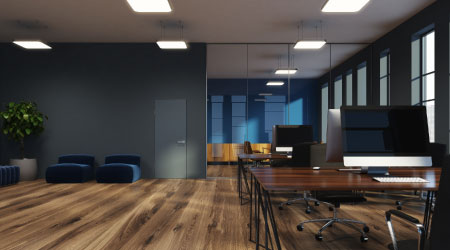A strong flooring program requires attention to sustainability, design trends, and budget concerns.
Planning a flooring project at an institutional or commercial facility involves more than ensuring that the floors are easy-to-clean and safe for building occupants.
Facility managers must consider a variety of factors such as cost, design trends and sustainability as well as factoring in disposing of the old product, installing the new one and establishing a maintenance strategy.
Managers need a well-vetted flooring plan that fits the needs of a variety of spaces from both design and performance standpoints. They may choose to seek out a supplier with design collections that are available in multiple sizes and thickness to allow for flexibility while also allowing for seamless design and ease of coordination.
“Today we’re seeing the need for products that help with both the flexibility and adaptability of space,” says Keith Richardson, director of performance markets-healthcare and senior living for Patcraft. “As these settings continue to shift and evolve, facility managers are tasked with creating adaptable spaces that offer a range of solutions, addressing different needs and uses throughout the day.”
In healthcare, education and workplace environments, spaces need to be multifunctional. Flooring is often an integral part of this solution as it defines space in “natural and intuitive ways while also offering a durable, high-performing product that will withstand the demands of a busy environment,” Richardson says.
As with any facet of operations, choosing the right flooring for the right environment is important. Flooring that includes different attributes such as durability and cleanability, appearance retention and ease of installation and quality and functionality provides a solution for design that blends experience and performance.
“It is important for flooring to meet the many and often differing needs of commercial spaces while supporting the broad range of activities seen across these environments,” says Richardson.
A flooring solution that uses hybrid materials has the benefits of a soft surface with tactile textures and acoustic properties combined with the durability and cleanability of a hard surface.
Aligning with timing
Facility managers continue to prioritize products that fall within their budget, provide ease of maintenance “and align with their project timing,” says Paula Meason, marketing activation manager for Interface Inc.
As the redesigning of interior spaces continues as workplaces adjust to a new hybrid workforce, institutions and commercial facilities are more likely to consider products that provide design flexibility for current and future needs.
“Companies are returning to the office and refreshing their workspaces,” Meason says.
Flooring companies can help managers build more flexible spaces that also deliver better aesthetics.
Meason is seeing a continued interest in biophilic-inspired flooring across a variety of commercial spaces. Incorporating biophilic design elements through color, texture, and pattern into interior spaces “connects occupants to the natural world, and can help create spaces that fuel productivity, spark creativity, and support improved outcomes,” she says.
Budgeting is a primary area that building owners are concerned about. Many facilities today are experiencing budget cuts and staff shortages, making product selection even more important.
“Given this, streamlined installation and maintenance protocols are increasingly influencing product selection,” Meason says.
Procurement guidelines, government regulations, net-zero pledges, corporate carbon commitments and other influences are all working together to encourage the specification of low-carbon building materials, including carpet tile.
“We’re seeing that the sustainability attributes of flooring products are becoming a key consideration in specification,” Meason says. “This is due to an increased focus on the decarbonization of buildings in both the private and public sectors.”
Disposal — the collection and recycling of post-consumer vinyl-backed carpet — has also become a selling point for suppliers. Products are being reclaimed and diverted to their most sustainable option, be it reuse, recycling or energy recovery.
Howard Riell is a freelance writer from Henderson, Nevada.
Related Topics:

